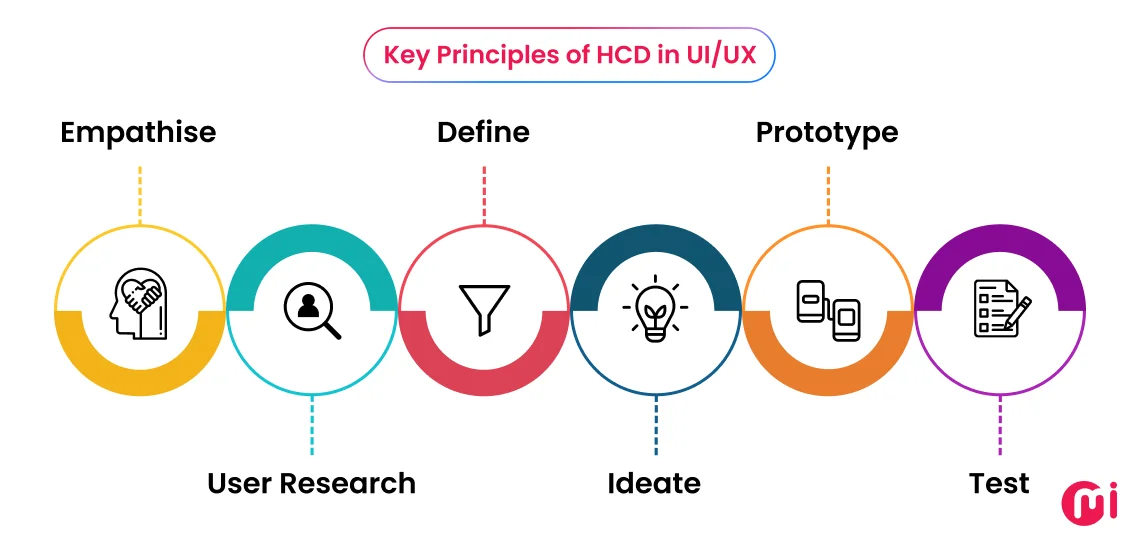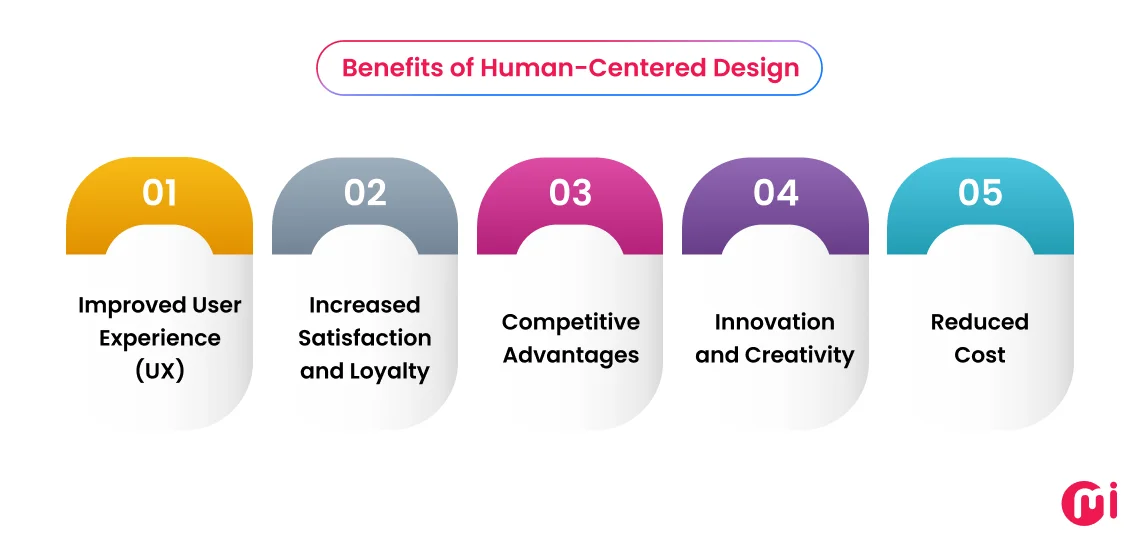What is Human-Centered Design? Principles, Process & Business Impact
- UI/UX
- May 30, 2025
Human-centered design (HCD), or humanized design, puts end users at the center of the design process. It begins with digging into users’ needs and challenges and building a product that leads to better experiences, stronger brand loyalty, and measurable business growth. Starting with the latest UI/UX statistics, this blog assesses everything about human-centric design and how it benefits business outcomes.
Did you know that 13% of people tell 15 or more people, while 72% tell 6 or more if they come across an unsatisfactory UI/UX. Worse, 67% claim a bad experience is the reason to churn. And, I’m sure you won’t afford to experience this outcome from your product, and that’s where human-centered design (HCD) comes into the picture.
Humanized design in UI/UX benefits users by creating visually appealing, effective, and high-performance products and services. It also benefits the product by increasing user satisfaction, improving adoption rates, accelerating market acceptance, enhancing brand reputation, and elevating customer loyalty.
In today’s competitive marketplace, those businesses that prioritize user needs outclass those that don’t. This blog will navigate you through a complete analysis of human-centered design and its impact on businesses.
The know-how in this blog will enable you to follow a strategic approach that aligns products with real users’ needs and behaviors, driving engagement, retention, and revenue.

What is Human Centered Design (HCD)?
Human-centered design, or humanized design, is a problem-solving framework and a fundamental approach in UI/UX design. It focuses on a deep understanding of users’ needs, behaviors, and emotions throughout the design process. The design process involves intense user empathy, iterative testing, and co-creation for product development that meets customer needs.
The human-centric design principle prioritizes end users by getting them involved early on in the design process. Following the very process allows UI/UX designers and a UI/UX development company to develop a final product that meets users’ needs and expectations.
Why Does Human-Centered Design Matter to Business Strategy?
Human-centric UI/UX design, by prioritizing user needs and preferences in the design process, leads to engaging and satisfying experiences. It enables businesses to understand users’ behaviors, goals, and pain points to deliver products and solutions that are usable, intuitive, and appealing. Here’s more about how to ace the UI/UX design process by employing HCD design:
1. Customer-Centric Design Leads to Deeper Loyalty and Engagement
By designing products to cater to real user needs, businesses provide satisfactory solutions, create emotional connections, and increase repeat users. Airbnb, for example, redesigned its booking experience after in-depth interviews and usability studies with both guests and hosts. Be it simplified flows, clearer pricing, and responsive support features, they were all guided by real user pain points.
2. Enhances Innovation and Product-Market Fit
Detailed user research, such as interviews and surveys, reveals unmet needs, brings awareness, and guides disruptive solutions. Businesses do so using various tools like voice-of-customer tools (Qualtrics) and prototyping tools (Figma, InVision), enabling streamlined validation.
3. Reduces Rework, Streamlined Time-to-Market
Early usability testing in human-centered design detects flaws before product development, which minimizes costly fixes. UI/UX designers employ automated user testing platforms such as UserTesting.com for smooth testing and a flawless product development experience.
4. Provides a Distinct Competitive Advantage in Saturated Markets
Superior UX, powered by exclusive UI, becomes a brand differentiator for businesses. Apple and Airbnb are a few examples of these businesses. Tools like Optimizely for A/B testing and accessibility checkers like axe DevTools can be used for inclusive design.
Key Elements of Human-Centric UI/UX Design
Take a look at the following pointers to know the key elements of human-centered design, or humanized design in UI/UX:
- Empathy Mapping: It is the process of comprehending users’ pain points, perspectives, and motivations.
- Deep User Research: Intense user research occurs using a range of techniques, including interviews, surveys, and user testing, to gather information about users’ needs.
- User Personas: It’s all about developing representative user profiles with the goal of directing design choices.
- Interaction Design: Interaction design is about designing interface components like menus, buttons, and icons in a way that users can interact with them.
- Accessibility: Ensuring the inclusivity of the product, ascertaining that it is usable even by people with disabilities.
- Simplicity & Usability: Creating a user-friendly interface and ensuring the design is easy to understand and use, limiting complexity.
- Testing and Prototyping: Rapid prototyping and user-centered testing to identify usability issues and fix them, ensuring the design meets the needs of end users.
- Emotional Engagement: Creating designs that evoke positive emotions in users, fostering emotional engagement, leading to the user’s satisfaction and loyalty.
What are the Key Principles of Human Centered Design in UI/UX?
The following are the key principles of human centered design process, including empathizing with user research, ideating, prototyping, and testing:

1. Empathise
In human-centered design, empathy is a fundamental principle that emphasizes the significance of understanding and sharing the needs, perspectives, and feelings of users. In this principle of HCD, UI/UX designers strive to understand the user’s understanding and emotions and get data on what the customer is willing to get through a product.
2. User Research
Similar to empathizing, the user-centric evaluation involves understanding user needs, behaviors, and motivation through different methods such as interviews, observation, and surveys. It helps designers understand a product’s requirements from the user’s perspective. User research is a crucial stage of the iterative HCD process, which ensures designs are effective and usable.
3. Define
Researchers, in this phase, distill the data and pinpoint problems and user needs. They do so by using frameworks like “How Might We” questions. In this stage, UI/UX designers turn raw data into clear product design opportunities to solve issues. Personas and user stories tend to emerge to keep the focus maintained on real user needs throughout product development.
4. Ideate
In this very stage of human-centered design, cross-functional teams create diverse solutions through structured brainstorming techniques. This technique may involve sketching or SCAMPER, mind mapping, or worst possible idea exercises. Through these methods, the designers reimagine existing solutions through different lenses, ensuring the development of highly possible products and solutions.
5. Prototype
Prototyping allows teams to rapidly create tangible representations of a product design. Designers create paper sketches and interactive digital mockups to visualize the prospective solution. The focus remains on making concepts testable rather than polished, allowing stakeholders to test the concept before making an investment.
6. Test
Testing allows UI/UX designers to gather users’ feedback through usability tests. While real users interact with prototypes, the researchers get the opportunity to observe behaviors and gather feedback. This iterative procedure helps them identify what works and what doesn’t, enabling refinement. The testing continues unless the product starts meeting users’ needs effectively.
Benefits of Human-Centered Design on Businesses
By prioritizing users’ needs and preferences, humanized design provides significant benefits to businesses. These business benefits involve enhanced innovation, improved customer satisfaction, increased brand loyalty, and reduced development costs. The following are the key benefits of human-centered design you should know:

1. Improved User Experience (UX)
Human-centered design benefits businesses through improved user experience by prioritizing user needs and behaviors in the design process. It promotes empathy, fosters innovation, and brings the product into alignment with real-world user expectations. It makes the products and services way more intuitive, effective, and enjoyable for users, which leads to increased user experience and satisfaction.
2. Increased Satisfaction and Loyalty
Human-centered design prioritizes user needs and helps develop a tailored product that directly relates to the user’s pain point. These products tend to be more intuitive, enjoyable, and satisfactory to the end users. It enables businesses to let their users feel understood and valued, making them satisfied with the product or service and fostering retention and loyalty.
3. Competitive Advantages
In today’s immensely competitive marketplace, those prioritizing humanized design are more likely to outclass their competitors. Human-centered design focuses more on users’ needs and helps create solutions that are completely tailored to their unique needs. The very approach fosters improved customer satisfaction, brand loyalty, retention, and a competitive edge.
4. Innovation and Creativity
HCD design, which prioritizes understanding and bridging the gap between what users need and what they want, encourages a wider perspective and fosters innovation and creativity for problem-solving. It is a proactive method to ensure that a specific product design meets users’ expectations, yields meaningful connections, and drives business growth.
It encourages a mindset of frequent innovation and improvement, which leads to excellent solutions for users’ problems.
5. Reduced Cost
Since it focuses more on users’ needs, behavior, and preferences, the human-centered design cuts down the cost spent on product development through various measures. These involve maximizing efficiency, minimizing rework and post-launch adjustments, and limiting customer service issues. The minimized expense of the product development leads to high-end, satisfactory product development and better profitability.
Understanding Human Centric Design Through Real-Life Use Cases
Now that we know human-centered design is a user-focused approach aimed at problem-solving, where the user’s needs are central to the design process, it is time to explore some real-life examples. Here are a few real-life examples of humanized design in action, including Apple’s iPhone, Google Maps, Airbnb, Spotify, and many more:
1. Apple’s iPhone: The HCD Revolution in Your Pocket
Who doesn’t know the exasperating experience of complex smartphone features? But now, the scenarios have changed with Apple’s iPhones. Apple follows human-centered design principles to meet users’ expectations. As a result, the iPhone’s UI is known for its simplicity, easy navigation, and aesthetically pleasing design, delivering a user-friendly experience.
How HCD Helped Apple:
- iPhone comes embedded with an intuitive multi-touch interface (no stylus needed)
- It offers a physical home button as a “safety net”
- App icons in iPhones mimic real-world objects (calendar, camera, notepad)
2. Google Maps: From Paper Maps to Predictive Assistance
Initially named “Google Local,” Google Maps employs human-centered design principles, prioritizing user needs and preferences from initial research and testing to the final product’s features and functionality. This way, Google understands the way people navigate, accumulate information relating to their needs, and design and reiterates the app in a way that is intuitive and convenient to use.
How HCD Helped Google Maps:
- Google Maps provides color-coded traffic flows that match human perception (red = bad)
- Features voice navigation that adapts to missed turns
- Visualizing local business photos to eliminate decision anxiety
3. Airbnb: From Near-Bankruptcy to $100B Through HCD
To deal with untrustworthy listings and poor photos, Airbnb employs human-centered design. It prioritizes a user-friendly interface and tailored experience through intuitive navigation, streamlined booking processes, trust signals, and mobile-first design.
How HCD Helped Duolingo:
- It provides no-cost professional photography for hosts (occasional)
- A Review system that builds social proof
- It provides “Wish Lists,” enabling it to tap into travel dreams
4. Duolingo: Making Language Learning Addictive
Duolingo is one of the top human-centered design product examples. This language-learning app offers almost 40 languages for studying. Duolingo has disrupted the landscape of language learning by employing human-centric UX design principles.
How HCD Helped Duolingo:
• Duolingo offers gamification with daily streaks
• Provides bite-sized 5-minute lessons
Challenges and Solutions of Implementing Human-Centered Design
Implementing human-centered design may be challenging, encompassing many difficulties. These challenges may be, for example, understanding the diverse needs of users, ensuring inclusivity, and integrating HCD into existing organizational structures. Here are some prospective challenges you might face when implementing human-centered design:
1. Aligning Business Goals With User Needs
When you have a wide range of audiences to target, it becomes tiresome to align business goals with users’ needs.
Solution: UI/UX designers break down the broad audience into specific, small groups and tailor UX strategies for each. They consider using A/B testing to find where the business goals and user needs overlap. For example, Amazon’s “Recommended for You” boosts sales and UX.
2. Balancing Aesthetics Vs Functionality
Striking the right balance between intuitive usability and visually appealing designs may lead to conflicts and challenges.
Solution: Designers adopt a user-tested, iterative approach where prototypes validate both enhanced usability and visual appeal. They make use of tools like Figma’s design systems to help maintain brand aesthetics while ensuring WCAG (Web Content Accessibility Guidelines) compliance.
3. Time and Resource Investment in Research
Deep user research, like interviews, requires a significant amount of time and budget, which can be a challenge for stakeholders to deal with.
Solution: UI/UX design companies leverage lean methods like guerrilla testing or AI-driven analytics, such as Hotjar or Maze, to gather insights timelessly. Besides, they show ROI through metrics like reduced churn or higher Net Promoter Score (NPS).
Getting Started on Human-Centered Design: A Strategic Roadmap for Leaders
As a decision maker, you need a strategic roadmap to successfully implement human-centered design. Here’s a detailed roadmap, which consists of auditing current gaps, identifying a pilot area, upskilling teams, and embedding empathy and user metrics into your KPIs. Explore and implement the roadmap to simplify your humanized design!
1. Audit Current Experience Gaps
First off, conduct a detailed assessment of UX and user feedback to find out weak areas. You can use tools like Hotjar and Google Analytics for UX analytics. Determine where the user needs to change from business objectives to prioritize human-centered improvements.
2. Identify One Pilot Area (Product Or Service) To Apply HCD
Now, select a focused, more measurable project, for example, checkout flow and onboarding, to test and ascertain your human-centered design principles. Keep in mind that a small-scale pilot limits the risk while offering ROI for wider adoption.
3. Upskill Teams Or Collaborate With HCD Experts
Consider training your internal teams in human-centered design methodologies (workshops, certifications), or just hire UI/UX designers to help you bridge the gaps and streamline human-centric product design.
4. Embed Empathy And User Metrics Into Your KPIs
Consider shifting from hackneyed metrics like clicks to user-centric KPIs, such as NPS. Opt for a regular review of these alongside your day-to-day business activities and goals to ensure excellent alignment and frequent improvement.
Future of Human-Centered Design in Digital Product Design
The future of human-centered design in software product development is characterized by the increasing integration of artificial intelligence (AI) and a focus on sustainability and ethical design practices. Enabled by these trends, the future of HCD design will lead to more seamless, personalized, and environmentally conscious digital experiences.
1. AI-Powered Personalization in UX
AI will play an instrumental role in tailoring digital experiences to users’ needs based on their past interactions, behavior, and preferences, leading to more personalized and intuitive interactions. This involves predictive analytics to anticipate user needs and proactively provide relevant information or features.
Businesses will also be using AI to automate tasks, freeing users to focus more on highly meaningful tasks, limiting cognitive load. For AI-powered human-centered design solutions, you’ll need to connect to an AI/ML development company to ensure your product is user-centric.
2. Sustainability and Ethical Design
Sustainability and ethical design will be mainstream. Designers will be prioritizing ethical sourcing practices, eco-friendly materials, and sustainable design principles that minimize environmental impact. Ethical considerations, including bias, privacy, and algorithmic transparency, will be a priority, ensuring that the digital products remain fair and equitable for different users.
3. Intuitive User Interfaces
Voice and gesture-based interfaces are anticipated to be more prevalent, providing natural and hands-free interaction with digital products. Augmented reality and virtual reality (AR/VR) will be making products immersive and realistic before making a purchase. It enhances the design process and user satisfaction.

Conclusion: Designing for People is Designing for Growth
As we have discussed in the intro above, “13% of people tell around 15 people when they encounter UX, not pleasing enough. That’s where you should design for people, which will turn out to be the reality of your business growth.
Human-centered design allows you to have a holistic view of what your customers actually want. With a thorough understanding of users’ needs and behavior, this design strategy enables you to cater to your users’ unique needs and preferences.
Needless to say, human-centric design brings immense benefits; however, when you choose the right UI/UX design company like MindInventory, it becomes the icing on the cake. Yes, we’re a team of vetted UI/UX designers, having delivered 450+ design projects across 90+ countries worldwide.
So, if you have a project to embark on, feel free to choose us as your human-centered design partner for optimized outcomes!
FAQs on Human-Centered Design
Human-centered design differs from traditional UX design by taking a holistic approach, considering a complete humanized experience, right from emotional and psychological factors to physical interactions.
Businesses can implement human-centered design principles by prioritizing the understanding of their target audience’s needs, behaviors, and pain points by way of research and observation. It involves empathizing with users, staying focused on the entire user journey, and iterating solutions based on the feedback.
Human-centered design provides numerous benefits, including improved user experience and satisfaction, increased brand loyalty, and a significant boost in business performance. When prioritizing users and their unique needs, businesses can provide products and solutions that are more effective, usable, and desirable. It leads to increased sales, customer retention, and a competitive edge.
To find the right UI/UX design company for humanized design, seek a team of UI/UX designers that understands and prioritizes your specific needs. Look for companies with robust portfolios that showcase extensive user research, human-centered design methodologies, and a collaborative approach to work.













